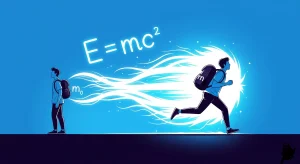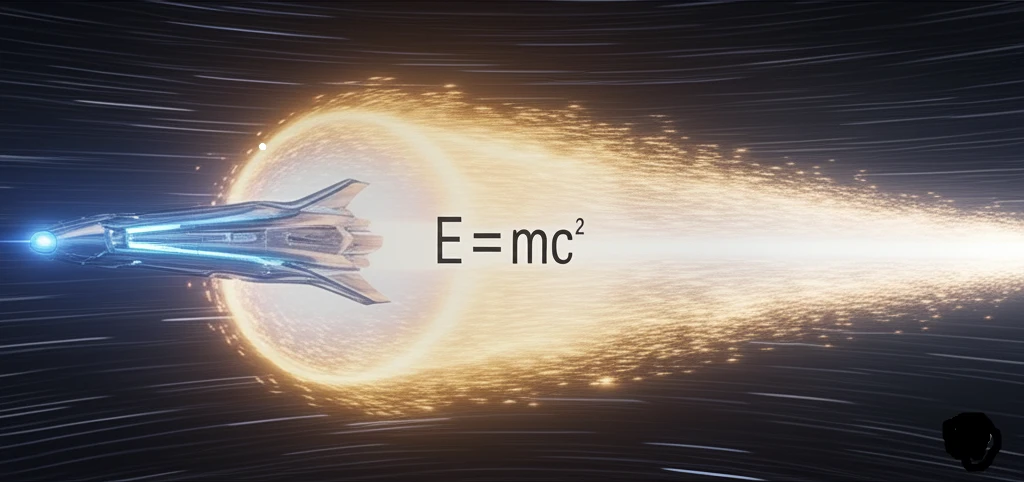It sounds like science fiction, but this is an astonishing rule of our universe discovered by Einstein.
“But why?” “What’s the difference between energy and mass?”
Let’s unravel these questions together, using that world-famous equation as our key!
Why Do Things Get Heavier as They Move Faster?
To put it simply, the reason is that “energy and mass are, in fact, the same thing.” The key to understanding this lies hidden in Einstein’s magic formula: “E=mc²”.
The Key is Einstein’s Magic Formula: E=mc²
You might have seen this famous equation at least once.
E = mc2
What this equation truly tells us is that “mass and energy are like twins that can transform into one another.” You can picture mass as a “tightly condensed chunk of energy” and energy as “the form of liberated mass.”
And the part that reveals the power of this equation is the “c²”.
▼ c²: An Unimaginable “Exchange Rate”

“c” is the incredible speed of light, approximately 300,000 kilometers per second. Its square, “c²”, becomes an unimaginably huge number (approximately 90,000,000,000,000,000).
The role this enormous “c²” plays is that of a “tremendous exchange rate” for converting mass into energy. Think of it like exchanging currency when you travel abroad, but for converting “1 kg of mass” into “energy” at an incredibly favorable rate.
Because this exchange rate (c²) is so massive, the disappearance of just a tiny amount of mass can create an explosive amount of energy.
▼ Real-World Examples Where This Equation is at Work
- Nuclear Power Generation: When uranium undergoes nuclear fission, the total mass after the split is slightly less than before. This tiny amount of lost mass (m) is converted into a vast amount of heat energy (E) at the enormous rate of c², which is used to generate electricity.
- How the Sun Shines: In the “nuclear fusion” occurring at the Sun’s core, a small amount of mass is also lost. This is transformed into the immense light and heat energy that has allowed the Sun to shine for billions of years.
Thus, E=mc² is not just a physics formula; it’s a magical equation that unveils the dynamic workings of the universe, holding the secret that “a tiny bit of ‘stuff’ (mass) has the potential to turn into an incredible amount of ‘action’ (energy).”
You’re Carrying an “Energy Backpack”!

Let’s consider this “mass and energy are the same” rule with an everyday example.
- You at Rest: Your weight when you are standing still is what physicists call “rest mass (m\_0).” This is your intrinsic, unchanging mass.
- You Starting to Run: To start running, you need “kinetic energy.” At this moment, imagine that an invisible “backpack” appears on your back, with a weight equivalent to the energy you’ve used.
- Getting Faster and Faster! The faster you go, the more kinetic energy you need, and the heavier your “energy backpack” becomes.
In other words, your “apparent weight” while moving fast is determined by your “original weight (rest mass)” + “the weight of the energy backpack.” That’s why the faster you move, the harder it is to accelerate (the heavier you become).
So, What Happens to 1g as it Approaches the Speed of Light?
This “energy backpack” becomes absurdly heavy as you get closer to the speed of light. Reaching the exact speed of light is impossible, but let’s look at a simulation of what would happen if we accelerated a 1g object infinitely close to it.
Shocking! A Simulation of Mass Increasing Explosively
| Object’s Speed | Apparent Mass of 1g Object (Weight including backpack) |
|---|---|
| 50% of light speed (~150,000 km/s) | ~ 1.15 g |
| 90% of light speed (~270,000 km/s) | ~ 2.29 g |
| 99% of light speed | ~ 7.09 g |
| 99.9% of light speed | ~ 22.4 g |
| 99.99% of light speed | ~ 70.7 g |
| 99.9999% of light speed | ~ 707 g |
| 99.999999% of light speed | ~ 7,071 g (~7 kg)! |
| …… | …… |
| 100% of light speed | Infinite (\\infty) |
You can see how the backpack’s weight starts to increase dramatically once you pass 99%, right? And as you try to reach 100% the speed of light, the weight of the backpack—that is, the mass—becomes “infinite.” Since it would take an infinite amount of energy to move an object with infinite mass, an object with mass can never reach the speed of light.
Conclusion: The Absolute Speed Limit of the Universe
Let’s summarize the key points of this article.
- Objects get heavier as they move faster because the energy of motion is added to their mass according to the E\=mc^2 principle.
- As an object approaches the speed of light, its mass (the “energy backpack”) increases explosively.
- As a result, anything with mass can never reach the speed of light, making the speed of light the absolute speed limit in the universe.
It’s a strange and fascinating


コメント